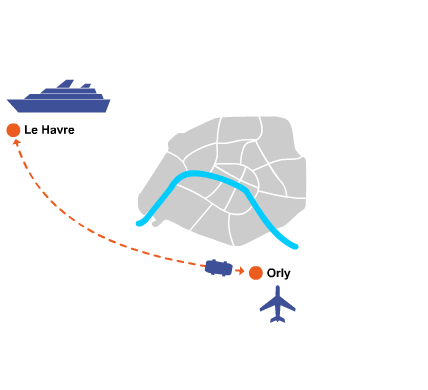Choose your route
Transfer Orly Airport - Le Havre

Orly Airport - Le Havre (Home address - Hotel - Harbour - Cruise terminal)
Private car and van transfer to/from Orly Airport to Le Havre
| Passengers | 1 - 2 | 4 - 5 | 6 - 7 | Action |
|---|---|---|---|---|
| Orly Airport - Le Havre | €390 | €460 | €480 | Book now |
| CDG Airport - Bayeux | €390 | €460 | €520 | Book now |
| CDG Airport - Caen | €420 | €480 | €520 | Book now |
Start your journey in comfort with our private transfer from Orly Airport to Le Havre. Perfect for travelers heading to the cruise terminal or city center, this route guarantees comfort and punctuality. Your professional driver will meet you with a personalized sign, ensuring a smooth departure. Along the way, unwind and enjoy the scenic ride to Normandy’s key port city. Once in Le Havre, take time to admire the impressive Saint Joseph Church and explore the unique architecture at the André Malraux Museum of Modern Art. Should you have any questions about your reservation, visit our your airport transfer FAQs section for instant answers.
Extend your experience with our Normandy routes. From CDG Airport, our door-to-door service also connects you to Bayeux, known for its historic tapestry and grand cathedral, or to Caen, home of the formidable Château de Caen and the moving Memorial Museum. These transfers offer stress-free alternatives to trains or car rentals. Let our chauffeur handle the road while you travel in comfort, enjoying your trip from start to finish. Pricing details can be found on our your airport transfer rates page to help you plan ahead with transparency and ease.
Book a private shuttle transportation from Orly Airport to Le Havre
- The reconstructed downtown of Le Havre
- The Museum of Modern Art André Malraux
- Deauville Airport
- Stay at the 1872 Stadium hotel
- 3 Good Reasons to Visit Le Havre Beach
- How to get from Orly to Le Havre by car


















